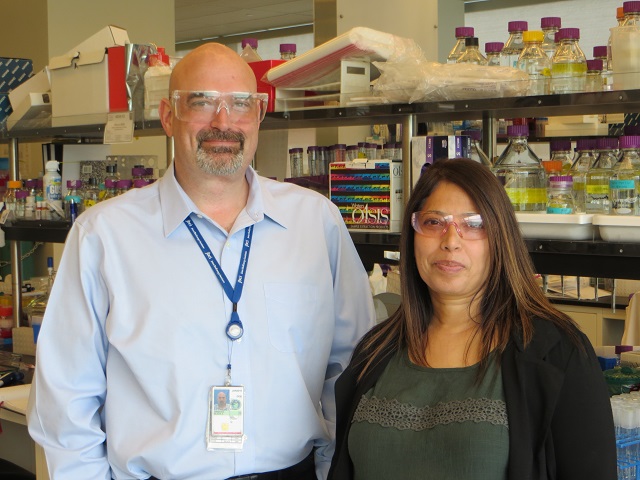 Blake Simmons and Seema Singh of the Joint BioEnergy Institute (JBEI) are leading an effort to improve the economics of biofuel production through improved deconstruction of lignocellulosic biomass.
Blake Simmons and Seema Singh of the Joint BioEnergy Institute (JBEI) are leading an effort to improve the economics of biofuel production through improved deconstruction of lignocellulosic biomass.
Researchers at the U.S. Department of Energy’s Joint BioEnergy Institute (JBEI) have successfully developed bionic liquids from by-products obtained during biofuel production. These new bionic liquids may pave the way for a closed loop process in future lignocellulosic biorefineries.
While the powerful solvents known as ionic liquids show huge potential for liberating fermentable sugars from lignocellulose and improving the economics of advanced biofuels, bionic liquids could offer a more advanced solution.

Image Caption: Bionic liquids derived from lignin and hemicellulose show great promise for liberating fermentable sugars from lignocellulose.
Blake Simmons, Chief Science and Technology Officer at JBEI, informed that lignin is normally burned to produce heat and electricity which are used in biorefineries. However, such refineries can benefit from new applications of lignin and thus increase their overall economic value.
The new concept of bionic liquids discovered by JBEI researchers offers a promising option to develop a closed-loop process for potential lignocellulosic biorefineries. This novel concept may also provide long-term economic value for other process technologies using ionic liquids produced from petroleum sources.
Next generation biofuels can be made by using cellulosic sugars that are stored in agricultural waste and grass biomass. These biofuels can reduce the environmental impact caused by fossil fuels, which account for about 9 billion metric tons of carbon emissions each year.
However, in order to ensure that biofuels are commercially viable, efforts should be made to improve their economic value. This can be achieved by developing advanced technologies to obtain fermentable sugars stored in cellulosic biomass and later developing them into fuels and other useful chemical products.
This concept however has a major drawback. Biomass contains complex polysaccharides that are deeply integrated into a strong woody material known as lignin. JBEI researchers have been using ionic liquids to pre-treat the biomass. The outcome of this experiment resulted in imidazolium-based molten salts that are normally produced from natural gas or petroleum.
Although imidazolium-based ionic liquids are suitable for biomass pretreatment, their cations are very costly. To overcome this issue, the researchers used aromatic aldehydes in hemicellulose and lignin to develop tertiary amine-based ionic liquids, which were later used to deconstruct biomass stored in switchgrass, an important crop used for producing liquid transportation fuels. The biomass was then subjected to an incubation period of 73h with the new bionic liquids, following which sugar production was found to be 70 to 75% for xylose and 90 to 95% for glucose. These yields are similar to those achieved subsequent to pre-treatment with the imidazolium-based ionic liquids.
Therefore, lignin and hemicellulose provide a suitable solution for making low-cost polymers and at the same time help realize a closed-loop process, wherein lignin can be reused to develop more bionic liquids.